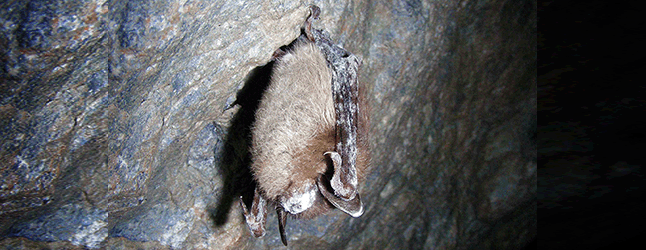
By David F. Rooney
Lethal White Nose Syndrome appears poised to leap into the Kootenays after the discovery of an infected Little Brown Bat like this one near Seattle on March 31 by US Fish & Wildlife Service biologists. The fungus has killed about 10 million bats in North America.
On 31 March, 2016, Washington Department of Fish and Wildlife confirmed that White-Nose Syndrome had been detected on a dead bat near Seattle, Washington, prompting warnings from BC bat expert Juliet Craig..
“This is very worrisome for the health of bat populations in British Columbia,” Craig, coordinator of the Kootenay Community Bat Project (KCBP) and BC Community Bat Program, said in a statement this week. “The BC Community Bat Program in collaboration with BC government and Wildlife Conservation Society Canada is developing a rapid response to this emerging crisis.
“We knew this deadly fungus that kills bats was moving westward across North America but we thought we had many years to prepare.”
Currently there are no known treatments for White Nose Syndrome that can be used to save bats in the wild. However, mitigating other threats to bat populations and preserving and restoring bat habitat may provide bat populations the resilience to rebound from the mortality that may be caused by the disease. This is where the KCBP and the general public can help.
“Although White-Nose Syndrome affects bats in caves, it will be during springtime when bats return to building roosts that we have our best chance at detecting the presence of the disease, making the work of our community bat program more important than ever before,” Craig said.
Funded by the Columbia Basin Trust, Habitat Conservation Trust Foundation, and the Habitat Stewardship Program, the KCBP conducts public outreach activities, responds to public reports of roosting bats in buildings, promotes the installation of bat houses, and coordinates a citizen-science bat-monitoring program.
“We are asking the public to report dead bats to the toll-free phone number or email below and to also provide information on bat roosts,” Craig said. “Bat carcasses will be submitted for testing of White-Nose Syndrome and may provide the earliest indication of the presence of the disease in BC.”
If you find a dead bat, be sure not to touch it with your bare hands. Collect it in a bag and label the bag with the date, location and your name, and then put the bag in the freezer. Contact the KCBP as soon as possible for shipping directions and further information.
The KCBP also encourages residents to report bat roosting sites in building structures, such as attics, sheds and bat houses, to help identify where certain species are present; if you are needing to evict bats from a structure, you are encouraged to contact the KCBP who can provide information on proper procedures to follow.
To contact the Kootenay Community Bat Project, email juliet@kootenaybats.com or call 1-855-922-2287 ext. 14.
Parks Canada, meanhile, is expected to make a statement early this week regarding the WNS threat. National Parks throughout the mountains are readying themselves for an encounter with this deadly pathogen. The biggest problem is that they thought they had perhaps five years before the fungus arrived here. Now that WNS has performed an end run it it appears as though Parks’ scientists have less time than expected.



